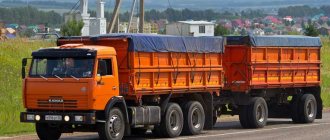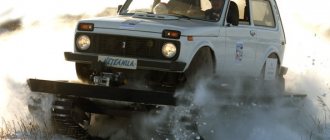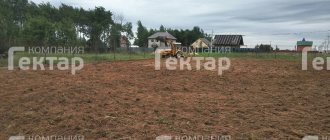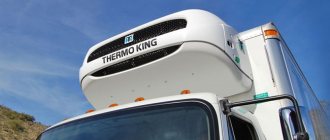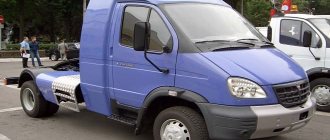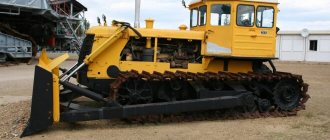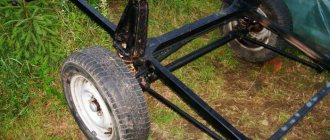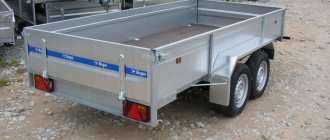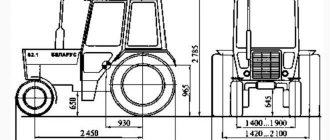More recently, car drivers were able to get acquainted with a new invention. Tracks for a car make it possible to turn any car into an SUV. With such a car you can freely overcome washed-out roads, drive through swamps and snowdrifts. This device is easy to install. The entire installation will take a maximum of 40 minutes. There is no need to invite a specialist for installation. This operation is available to any motorist.
Which is better: wheels or tracks?
People first started talking about tracks on a car in the 50s of the 19th century. This device was developed by F.A. Blinov. The American company Holt began producing such systems for tractors in 1912. Tracks on wheels were developed specifically for cars that constantly had to overcome off-road conditions.
Unfortunately, this new product had a number of characteristic disadvantages. First of all, this concerns the weight of the structure. The gooseneck on a car is made of metal. Its mass reaches 25% of the weight of the entire machine. Of course, there are collapsible systems. They are much lighter, but their cost is very high. This design is imperfect and breaks quickly. Repairing such models is very difficult.
Additionally, we recommend reading our expert’s article, which talks about how to make anti-slip bracelets with your own hands.
Tracks for a passenger car are considered the cheapest. They are made of rubber and steel. Unfortunately, the device has poor grip on the road and has a short service life. A tracked vehicle makes a lot of noise and consumes a lot of fuel. This is why track wheels on a machine are inferior to wheel drive. However, they benefit in increasing the vehicle's cross-country ability.
Main advantages
The advantages are obvious - improved cross-country ability. As well as an increase in ground clearance. Deep snow in the fields, swamps of small swamps, and simply “well” washed out roads become easy obstacles. If we take into account what these tracks were originally developed for, it was to overcome deep snow, they were made for rescuers on mountain roads where ordinary SUVs simply cannot pass. What can I say, the caterpillars have proven themselves only from the best side.
For example, watch the video where the NIVA easily passes through deep snow and turns around “calmly”.
Changing shoes from regular wheels does not require any changes in the suspension design; you can remove the wheels with your own hands and hang the tracks in literally 1 hour. Moreover, if you need to return the wheels back, an hour and they are there. This adds a very big plus.
Devices for increasing cross-country ability
Almost every car can have such a device installed.
In addition, it can be easily mounted on other types of transport:
- motorbike;
American inventor B. Soden figured out how to install tracks on wheelchairs. The Mattracks company managed to create a system that was equipped with the T-1 Battle Unit robot shown in the third Terminator. Of course, this is just a prop for creating PR.
Mattracks manufactures 20 rubber models that are installed on SUVs. As a result of this update, the car is able to overcome any obstacle. It turns into a real all-terrain vehicle.
On the Internet you can see a large number of converted cars that have tracks instead of wheels. All these designs are made by hand.
Moreover, they all have characteristic differences.
- A car is placed on the platform. The long caterpillar is connected to the machine using special gearboxes.
- Instead of wheels, independent systems in the form of a triangle are installed. After modification, the wheel disc becomes a sprocket. Wheels of smaller diameter are attached to a triangular frame.
- The easiest way is to move the device beyond the dimensions of the machine. To create one track, the front wheels are placed in the belt together with several wheels of smaller diameter. The appearance of such a car resembles a military tank.
All about excavator tracks
Let's look at what types of tracks there are, who makes them, how excavator tracks differ from each other, and how to select them.
Tracked vehicles are the most common among road construction equipment. Unlike a bulldozer, an excavator is used only for earthmoving work, and they come in both tracked and wheeled versions. Why are there more caterpillars? They are gentle on the soil, can be used in any weather, and can work on any surface.
Thus, on the one hand, a gentle regime for the territory in which you have to work, on the other hand, the ability not to spare equipment and work at any time and on any soil leads to a natural choice in favor of tracks. The main thing is to choose reliable, wear-resistant tracks.
What types of caterpillars are there?
The running system of a crawler excavator includes the following components:
- A suspension that includes a frame with a rotating support.
- The mover is a caterpillar, a drive wheel, support rollers, support wheels, a tensioner and a guide wheel.
Excavator track suspension and propulsion unit
Different models have different structures; schematic images of their various variations can easily be found on the Internet, but the basic design of the propulsion unit is as follows:
Propulsion, track assembly: track, drive wheel, support rollers, support wheels, tensioner and idler wheel
The suspension structure is as follows:
Excavator chassis suspension structure
The track structure depends on the excavator model. There are compatible ones.
To choose reliable tracks and generally understand them, you need to know the manufacturers. First of all, excavator manufacturers. Among the worthy manufacturers of crawler excavators there are domestic and foreign ones.
Domestic manufacturers of crawler excavators:
- "Uralvagon,
- "Exmash"
- "Promtractor"
- "Kranex"
- "Kartex".
Foreign crawler excavators are produced under the following brands:
- Caterpillar,
- Komatsu,
- Volvo,
- Hitachi,
- JCB,
- Hyundai
- Liebherr,
- Bumar,
- Doosan.
Komatsu and Caterpillar excavators are assembled in Russia at the following enterprises:
- "Caterpillar Tosno"
- Komatsu Manufacturing Group.
Accordingly, they all produce tracks (or a chain with tracks).
Three types of tracks for excavators
There are three types of tracks for excavators, depending on the material:
- rubber,
- metal (steel),
- rubber-metal.
When creating an excavator model, the manufacturer has already selected possible types of caterpillars, and the selection criteria are as follows:
- rubber or rubber-metal tracks for an excavator operating in the city,
- rubber tracks for soft soils, on slopes where it is important not to damage the soil (rubber pads are also used for this),
- metal tracks are used on difficult ground,
- metal tracks are used for work in winter.
The width of the track is also selected based on the specifics and working conditions. The wider the caterpillar, the less it will damage the soil and the better the excavator will pass through muddy soils. Wide ones are used for soft soils, but are better suited for stone surfaces
Rubber tracks for excavators
The main advantages of rubber tracks are gentle pressure on the ground, better grip on the ground, and overcoming a greater angle of inclination. Rubber tracks are relevant for agricultural and construction equipment.
Rubber-metal - with a steel core in rubber - make the track more wear-resistant. It becomes less susceptible to ruptures and its service life increases.
To select a rubber track, three parameters are important:
- Track width,
- Distances between track axles,
- Number of tracks.
The width varies, for example, 180, 190, 200, 230, 250, 280, 300, 320, 350, 400 and 450 mm. The distance between the axles of the tracks is 48, 60, 72, etc. The number of tracks is from 40 and above.
For example, a caterpillar with parameters 230X72X56 is:
- Width 230 mm,
- Distance between track axles 72 mm,
- Number of tracks 56.
Rubber tracks are actively used in mini-excavators.
Metal tracks for excavators
Metal tracks cannot be used in the city, on asphalt. They are used on difficult surfaces and, depending on the nature of the surface, are equipped with shoes with 3, 2 or one lug. The lug is a protrusion or ridge that increases the area of the bottom surface of the shoe.
The lower the ground pressure should be, the more lugs will be needed.
Shoes with one grouser are used for the surface, in gravel, in fragments of rocks, with hills, where you need to penetrate deeply into the supporting surface.
Historically, Russia mainly used metal tracks. They last longer. Rubber ones are considered only for equipment up to 13 tons and are just beginning to gain popularity.
Most metal tracks are compatible with many models of excavators and bulldozers, the only difference is the shoes. Shoes are assembled from special profiles, from special profiles with a width of 207 to 1200 mm, depending on the model of equipment.
The parameters of the metal track chain include:
- Number of links
- Link pitch (mm),
- Link height (mm),
- Hinge type (dry, closed with lubricant).
The most common number of links: 43, 45, 46, 47, 48, 49, 50, 51, 52, 53. The link pitch is the distance between the centers of the track chain link eyes for the bushing-pin pair. Most often you can find link pitch: 171.45 mm, 190 mm, 203 mm, 216 mm, 260.3 mm.
In Russia, tracks are manufactured at the Cheboksary Aggregate Plant and at the Techtron enterprise. Among foreign manufacturers of tracks, the most popular are: Berco, ITM, USCO, STR, DSL.
We will help you choose a caterpillar for your excavator. +7 (343) 2-061-061.
If you need to buy spare parts for an excavator and other equipment from UralDetalService, please contact us for advice. We offer spare parts from the manufacturer, so the prices will pleasantly surprise you.
Nuances of system installation
Installation of tracked vehicle systems is quite simple. It is very similar to installing wheels. There are several factors that must be taken into account.
How to choose and install tracks for the Niva? Read about this in detailed material from our specialist.
- The frame must be equipped with a rod mount. It is to this that the tracked structure will be attached.
- The device cannot be installed on all car models.
- If the machine is equipped with a single drive, the design will not give a high effect. It functions normally only on a car with all-wheel drive.
- There should be plenty of free space under the wings. Otherwise, the tracks simply will not stand up, or it will be impossible to turn them.
- The device requires power steering in the car. The tracks adhere over a large area, and this makes it difficult to control the machine. Therefore, without power steering it will be difficult to maneuver.
It must be said that the motor power in this case can be any. The track disc is much smaller than the diameter of a conventional wheel. Therefore, the torque begins to increase. As a result, movement speed decreases. The manufacturer of such systems recommends not driving at speeds exceeding 65 km/h.
Types of tracks for snowmobiles
Despite the fact that all tracks for winter motor vehicles are structurally similar, they differ in a number of parameters, including the width and length of the transport belt, the height of the lugs, and the pitch. In many ways, the set of characteristics is determined by the type and purpose of the snowmobile itself.
Sports
For such snowmobile models, two types of tracks are usually chosen: for snow trails or for asphalt. In both cases, these are tracks of shortened length and with a narrow belt. This design provides the best maneuverability and excellent controllability of the equipment. The height of the lugs in such versions is no more than 0.75 inches.
Tourist
For such snowmobiles, it is first of all important to achieve an optimal balance of speed, cross-country ability, handling and maneuverability. Therefore, for tourist versions, tracks are chosen that have average length and width. Grouser heights are typically between 1.25 and 2.25 inches.
Utilitarian
Such snowmobiles often fulfill economic purposes, for example, transporting heavy loads and large products along difficult routes, so the task of the tracks in this case is to ensure maximum maneuverability and stability of the equipment. Long and very wide (more than 20 inches) models work well for this purpose. Grouser height: 1.5 - 2.25 inches.
Mountain
Snowmobiles of this type are equipped with tracks of a specific geometry - narrow and very long. This design makes it possible to achieve excellent maneuverability on inclined roads, while reducing the risk of rollovers. The lugs of the mountain versions also have a special shape. and their height reaches 3 inches.
Advantages and disadvantages of the design
Of course, tracks for a passenger car have a number of advantages. Even with the naked eye you can notice an increase in ground clearance, as well as high cross-country ability. The car easily overcomes deep snowdrifts, moves through swamps and washed out roads. At the very beginning, it was assumed that the tracks would be used for rescue work. They made it possible to easily reach places where large SUVs cannot drive. The conclusion is clear. Caterpillars have undeniable advantages over conventional wheels in certain conditions.
With a large number of positive qualities, caterpillars also have a number of disadvantages. First of all, this applies to driving on an asphalt road. On such vehicles, experts advise not to reach speeds exceeding 40 km/h. If you move at a higher speed, the caterpillar will quickly begin to wear out, and you will have to change it, since it cannot be repaired.
Another negative factor is the inability to cope with obstacles that ordinary wheels can easily overcome. For example, a tracked vehicle will not be able to move over a fallen tree or a small ledge (10-15 cm).
What to look for when purchasing
Caterpillars for winter motor vehicles also differ in other, more specific parameters. The following recommendations will help you decide what is best for you. At the same time, remember: the length, width of the belt and pitch for new tracks should be selected similar to the old ones installed on your snowmobile model.
Tape length and width
Calculated as the distance from the rear edge of the track to the front module. Most often, models are equipped with ribbons longer than 38.3 cm. The width is measured from the outer to the inner edge of the ribbon. The most popular parameters among the range of modern manufacturers: 30, 38, 50, 60 cm. At the same time, the most universal, suitable for both sports and mountain snowmobiles, is considered to be 38 cm wide.
Track pitch
This is an indicator that is calculated from the beginning of the previous window to the beginning of each next one. As a rule, manufacturers determine the parameter separately for each sample. Tracks with pitches of 2.52 and 2.86 inches have become more widespread. Steps of 3 and 3.5 inches are usually used in rare models of mountain winter equipment.
Height of lugs
For riding on loose snow and rough terrain, lug heights of 1.75 - 2.25 inches are best. For other roads, lower models are quite sufficient. When choosing a height, it is worth taking into account the power of the equipment itself, otherwise the motor simply will not cope with the load. The recommended indicators here are as follows:
- Engine up to 40 hp — lug height no more than 20 mm
- Engine up to 60 hp — lug height no more than 25 mm
- Engine over 60 hp - does not affect
Number of rows
On sale you can most often find tracks with a number of rows of 4, 6 and 8. The more rows there are, the higher the cross-country ability of the snowmobile will be. Therefore, also consider the quality of the roads you plan to drive on.
How to increase the service life of the undercarriage of tracked special equipment
Naturally, the key to the longevity of this system, which is under constantly increased loads during operation, is periodic inspections and preventative maintenance. Any person using such equipment must know a number of important rules that will increase the service life of individual elements of the track system, as well as the entire chassis as a whole:
- Constant monitoring and maintenance of cleanliness between operations.
- Try to use reverse gear as little as possible to move.
- The technology must work. If there is no such opportunity for a long time, then it is recommended to periodically do small break-ins.
- It is advisable to check the reliability of bolt fasteners after each use of special equipment.
In addition, every 500 hours worked, it is recommended to do a more serious inspection and replace those elements that are most susceptible to wear.
Can I do it myself?
YES of course you can, why not! After all, they are also produced by people. However, you will need to do technical research, calculate the load, and weld the triangle. Look for rollers and the canvas itself (many people also make old rubber). As you can see, not everything is so simple - although it should be noted that it is feasible.
Look what people are doing in the garage!
However, it is advisable to only install purchased ones with your own hands - well, this is only if you really want it or if it is absolutely necessary. For example, you live in the far north, where there is snow 365 days a year.
This is where I end, I hope the article was useful to you, if you want to buy it for yourself, just go to the official website of the same “Mattracks”, now there are a lot of companies that work with them in Russia.
Similar news
- Restoring the leather on the steering wheel or how to paint it. Details + vi…
- Dry fog for cars (treatment). What it is? And for what...
- Lightweight piston. Why install? And is it possible to make your own...
